Rishad Tobaccowala's Blog, page 5
March 9, 2025
6 Ways to be Better.

Competition is not necessarily about besting other people but to get better every day and to get closer to what we believe are our ideals.
Our success is not housed in other people’s minds (what they think of us) but in their hearts (what they feel about us) and in our mind (what we think of ourselves).
Here are 6 ways to better.
 1. Accept the 3Ls of loss, love and learning.
1. Accept the 3Ls of loss, love and learning.In many ways Life is about Loss, Love and Learning (the 3 L’s)
Loss is central to the human experience in three ways. The first is we often lose in our attempts to succeed. We lose pitches, Clients, jobs, and opportunities. Many times, we win. Some people win little, and others win a lot. But we all lose. But these losses are not the big ones. The second bigger losses are the losses we will face of loved ones and friends either because relationships end, or death comes, and our final loss is that of our lives.
How we live amidst this loss defines a large part of life.
The joy we make is because time is precious, and this moment of victory may not last forever. Given that loss is part of human existence it pays to be kind and to think about how to help those dealing with loss. Do not ask for whom the bell tolls since it tolls for all of us.
A big part of what makes life worth living despite the guarantee of loss is the hope of love and joy of learning. Love of people, of work, of art, of culture. Love may not compute but computers do not love. There is a great deal of progress made over generations on who one can love, the ability to do things one loves and because of modern technology to be exposed to new worlds, horizons, and things to love.
And learning is particularly joyous. Learning in its first form is building knowledge. With great knowledge and practice we build skills and craftsmanship. Learning to see things from other perspectives gives us understanding. Sometimes if we are lucky, we can graduate from knowledge, skills and understanding to wisdom.
 2. Be Open.
2. Be Open.Today, like never, there is a pull towards being closed.
Our online media diets tend to be polarized as streams of algorithmic feeds optimized to engage, addict and make us feel good about ourselves may leave us believing that the stink of some of our more flatulent thoughts have the aroma of Chanel No.5
Today many want to build walls, exit multi-state treaties and organizations, demonize the other, look away from reality, facts, and truth.
Nationalism rises despite all the big challenges and opportunities are global in nature.
Covid-19 was global. Climate Change is global. China’s impact is global.
Whenever a company or leader or country falls, the history books all agree it is because they were closed to new ideas, new competitors, new people and new ways of doing things.
Be Open. To other ideas. To other perspectives. To other people. To other cultures.
 3. Mind the gap.
3. Mind the gap.Alain de Botton’s book “An Emotional Education”, notes that while many people teach skills and expertise very few people focus on how to live an emotional life. He decried much US self-help books that believe in the achieving perfection and having it all.
Today in the Instagram age so many of us try to be pixel perfect. But life is not pixel perfect.
In fact, most of life is “minding the gap”. The gap between who we are and what we want to be. The gap in communication between any two people. The gap between what we say/project externally and what we believe/live with internally.
The most contented people tend to be those who have narrowed this gap or being aware of it find ways to accept that life is incomplete, imperfect, often incomprehensible.
They are authentic, trustworthy, happy within themselves not needing constant external validation and have strong relationships and connections with people. They are vulnerable, empathetic, and constantly growing (often making mistakes as they do).
There are others who project power, fame, and wealth but you begin to see that often many have the warmth of a toilet seat and a vision that does not stretch beyond their elbows. All the external validation they have or seek does not fill the chasm of emptiness that echoes with hollowness and this truth burns and eats their inside even as they smile and blow kisses on the outside.
So, what to do?
George Saunders the Author said “Err in the direction of kindness”
Today in the world we have much rage.
So, best be kind.
Kind to others and to yourself.
This is one way in helping mind the gap.
 4. Compound Improvement.
4. Compound Improvement.The single most powerful concept in Finance is that of compounding.
Compounding interest and compounding returns can over time create wealth or lead one to bankruptcy depending on whether you owe or own capital.
If you start with 12,000 dollars and add 1,000 dollars a month every month for 30 years and it grows at 10 percent, you have just under 2.5 million dollars. The key is you set aside a small sum every month for a long time.
In a world of change we all may want to consider another way compounding can help us grow in changing times and drive mental, emotional, and even financial wealth which is compounding improvement.
If a company can only change, grow and transform if its people change, grow and transform, we should each invest in upgrading our own mental and emotional operating systems.
There is so much we cannot control in a world driven by global, demographic, social and technological change but instead of being buffeted about helplessly in a sea of chaos maybe we can try to control and build our ourselves to be better.
Three ways on how you might start this very minute begin to embrace Compounding Improvement
a) Discipline equals Freedom: This is the title of a book by Jocko Willink, a Navy Seal. Basically, if you want to get a grip on the world get a grip on yourself.
b) Invest an hour every day in learning: The world is changing so fast that many of our skills and expertise and mindsets need continuous upgrading. While many of us set aside time to exercise so as to maintain our physical operating system we need to also feed and exercise our minds. The power of this habit is that at the end of a year you will have spent 365 hours learning new things by just doing one hour a day. You will gain compound returns to thought!
c) Deliberate Practice: The late Professor Anders Ericcson w wrote a book called “Peak” which is the best study of deliberate practice. Deliberate practice involves three components 1) immediate feedback, 2) clear goals and 3) focus on technique. According to his research, the lack of deliberate practice explained why so many people reach only basic proficiency at something, whether it be a sport, pastime, or profession, without ever attaining elite status.
 5. Improvise like Jazz.
5. Improvise like Jazz.We are living in a jazz age and not a classical one.
In classical music —particularly orchestral music—there is a conductor that musicians follow, sheet music one sticks too and a hushed auditorium one sits in.
Jazz on the other hand is a mix of classical, swing, blues and much more but at its heart it’s about improvisation. It is about playing off each other. There is no conductor. Rare is there a hushed auditorium but more likely a noisy club or the anguish of a lonely saxophone in a subway station.
Today we are living in a diverse, global, and connected world where we have to work together, we have to fuse our different cultures and beliefs and constantly adapt and improvise
 6. Read Poetry.
6. Read Poetry.I have nearly 100 Poetry books at home each of which I have read significant parts over the past decades.
Why?
Here are how some Poets have explained the importance of poetry.
Perhaps you have been banged about by recent events. It can help to say words, walking helps. Poems help.
The meaning of poetry is to give courage.
Poems restore to us what is deepest in ourselves. It consoles us.
Greatest poetry is written at the borders of what can be said. It makes a strong effort at expressing the unsayable.
Poems are perfect words in perfect order.
They help us see and feel as these lines which I have extracted from different poems by James Wright’s book “The Branch will not Break” which all describe dusk in a Midwest prairie farm. Each line is filled with a new way of seeing and whenever I am driving in the evenings outside of Chicago, I sense things differently because of these lines. The sensing and seeing also helps in writing, photography and in paying attention…
Noticing matters.
Silos creep away toward the West
The cow bells follow one another into the distances of the afternoon
The sun floats down, a small golden lemon dissolves in the water
The moon suddenly stands up in the darkness
The moon drops one or two feathers into the field. The dark wheat listens.
And poems remind us of the passing of time…
Time is an echo of an axe within a wood
The sunlight in the garden hardens and grows cold, we cannot cage the minute within its net of Gold
But one day I know it will be otherwise…
March 2, 2025
The Great Separation/Reaggregation of Work.
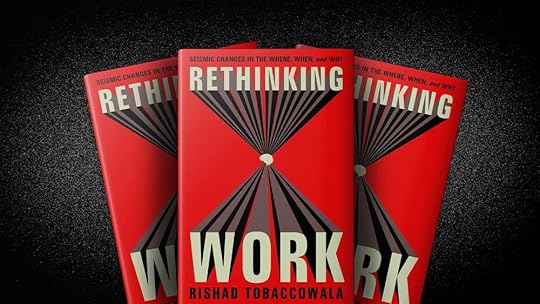
In the distant past, if one wanted to listen to music one had to go to where the musicians and the musical instruments were. The music, the musician, the musical instruments and the listeners were in the same place at the same time.
With recorded music the first separation occurred with music being able to be listened to where the phonograph was located and could be listened to at any time as long one had the disc. This was usually in the home since the equipment was heavy.
As time moved on the listening device got smaller and more mobile, first with radio and then the breakthrough technology of the Sony Walkman.
The final separation occurred when the device and the music were separated as well as every song was separated from the song next to it on an album
The individual song or piece of music was a digital file in a cloud but we now re-aggregate these songs into playlists based on our preference, mood, genre and many other ways.
Today music is streamed and listened to via a playlist either curated by us or by an algorithm.
This also is true for most media with linear television increasingly be replaced by streaming on demand television, the magazine being replaced by articles discovered via search and streams, and much knowledge and content made free and re-aggregated by the Chat GPT’s and Gemini’s of the world.
This process of music and other media separating from physical space, from device and from the content next to it is also well underway in the world of work.
We are moving to a world where a majority of work in white collar industries will be separated from physical space, and from “jobs”.
Companies will separate the components of a “job” into tasks and then allocate these tasks to a portfolio of resources that can get these tasks completed.
Some tasks will be allocated to full time employees, some to fractionalized employees, some to free-lancers, some to other companies and some to AI. These resources will be distributed everywhere in the world.
This has been happening for many decades but until recently for most industries has been a minority of the way work was allocated.
But now with a) nearly a third of work being done remotely, b) demographic change of declining populations and aging populations placing pressure on access to talent, c) two thirds of Gen-Z wanting to work for themselves, d) the continued rise and access of marketplaces (AWS, Shopify, Deel, Etsy, Uber) that allows access to buyers, producers and sellers and e) the rise of side hustles and gigs, a majority of work will be separated from full time jobs by the end of the decade.
And of course the great separation of tasks from jobs and for people working full time for an employer will turbocharged by AI which is driving the greatest efficiency and effectiveness drive that the world has ever seen. Just look at Meta’s growing revenue and rapidly declining head count as an early indication of what is underway.
This new world will allow companies to be deeply agile, manage costs, access expertise on demand, become global at launch and in most industries scale coverage and delivery with limited need for full time employees. Companies that fixate on expensive real estate, five days a week in the office, limit talent pools to certain geographies and insist on a zone of control over talent will be left in the dust by the new companies just like a swarm of drones and other technologies leaves the large lumbering aircraft carrier less and less relevant.
These trends will create many billion dollar revenue companies with fewer than 100 full time employees and will create significant opportunities but also many challenges to individuals, companies and societies.
Looking ahead we can expect:
a) Most companies having far fewer full time employees.
b) There will be more opportunities to work be far more companies and employment as more new businesses are created to serve the new needs and new industries AI and other technologies will make possible.
c) However much of this employment will be people being paid to do tasks, projects and gigs versus a full time job.
Many companies with full time employees will replace a large portion of jobs with tasks by leveraging platforms and systems to allocate their talent to wherever in the world they may be. Bosses will be augmented by ongoing mentors and shorter term project leaders.
This movement will create great challenges when it comes to societies where healthcare has been tied to full time jobs and also for the variation in income when most peoples costs are fixed and not variable.
It will also however create great opportunities for people to work in ways that fit their life and skills and allow them to diversify income streams versus being dependent on one job and a firm especially now the social contract between employee and firm is diminishing and mostly gone.
Everybody needs to think of themselves as a company of one by honing expertise, continuous learning, building a reputation and being a great collaborator and connector.
For companies and leaders it will require significant rethinking of everything from what how one leads today to organizational design and even the strategy of the firm.
Consulting companies like McKinsey and BCG and the Entertainment Industry operate in this way to a large degree. Consultants build particular expertise and are reaggregated with other consultants to execute assignments for Clients. Artists, writers, directors, caterers, gaffers, all work from gig to gig ( movie, show, event).
This new world of work is well underway but many are struggling with what the future will hold.
But the future is here and we will have to adapt to it because it will not adapt to us.
The decline of full time jobs and the rise of careers built around reaggregating tasks is what we should all prepare for.
Its time to rethink work both as talent and as leaders.
Last week two leaders of Fortune 500 companies having just finished Rethinking Work reached out to me via LinkedIn saying they had ordered hundreds of copies for their teams noting not just the clear-eyed data filled analysis and insights, but particularly the frameworks and approaches that allow each individual and company to build their own blue print . The book is not a screed but a customized operating manual to help individuals, teams and companies thrive in ways that fit their realities. Look below to see the components of the book and download the first section to see if it is for you and your firm at Rethinkingwork.io
For 25 copies deep discounts starting at 40 percent here: https://bulkbooks.com/products/rethinking-work-seismic-changes-in-the-where-when-and-why
The book is available in India for Rs 400 in book stores, Amazon India and Flipkart. HarperCollins India also has been providing discounted bulk sales.
Also available in Audible, Kindle and electronic book.
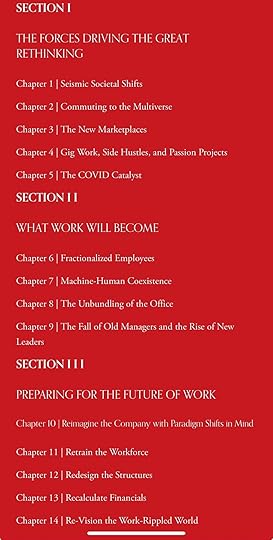
February 23, 2025
Old School Cool.

Earlier this month I recorded a conversation with Jack Klues whom I directly reported to for over 15 years and the podcast titled “Collaborative Leadership in the Age of Churn” resonated far and wide. Many appreciated in the very simple and human lessons he conveys about the importance of talent, humility, integrity, trust, and sensitivity to the different perspectives/ backgrounds as keys to winning and excellence.
I then re-listened to a podcast from the other person I reported to for many years, Maurice Levy in his episode Levy on the Level and found some of the same themes and beliefs from a person with a very different background than Jack but aligned like him in a quest for excellence with a deep reservoir of humanity.
Then I listened to other folks who are amazingly successful leaders who I worked alongside from Renetta McCann (It is about growth) to Michael Conrad ( Creativity and 7+) to even the most recent guest Jack Myers speaking about the Tao of Leadership and found that again and again they re-iterate their belief in values and qualities that are clearly evergreen but sometimes today feel “old school”.
Today amidst significant transformation driven by technology, politics, globalization and social shifts it may behoove us to focus on things that do not change.
They may go out of fashion but like a second heart they beat within us whether we wish to listen to them or not.
They endure.
Like something crafted and sculpted with care over time.
An underlying design and approach that keeps on working.
In fact these values and behaviors maybe critical to help us navigate and lead change since the leaders I have named have successfully transformed and disrupted models and driven great economic value creation using these principles.
The best leaders and companies seem to be adept at adapting the latest tools and techniques to ensure their firms are state of the art but also fuse these with the old traditions, values and beliefs to craft unique formulas that combine roots and wings to both soar and remain grounded.
Here are half a dozen characteristics we may want to think about as we face and navigate the world we live in. They endure and can help us endure.

1. Integrity: Integrity is when we say, what we believe and what we do are aligned. Among the best compliments one can get is that one is a person of their word. Children do not listen to what their parents say but watch what they do both in public and private. Integrity is a diamond that cuts through BS and like the Pink Floyd song suggests it shines on and on. It is an internal balance and harmony with external change.
2. Trust: Trust is speed because it removes friction and accelerates decision making and risk taking. If we trust our leader, our colleagues, our partners, and our investors it allows us to innovate, take risks, move fast, speak our mind, accept feedback and continuously improve. Outside of a few cases you should give trust to those you work with till they prove you wrong rather than get them to earn trust. Trust is often earned by showing the data one is using, be clear about one’s intent and goals and being transparent about the decision making process.
3. Patience:While Keynes reminded us that in the long run we will be dead hopefully many of us will be able to have a long run. In fact as Seth Green reminded us we will have 50 year careers and thinking long term and in the long run means we align with the weapon and power of time. Jeff Bezos of Amazon used longer time frames to invest and build and was not focussed on quarterly or annual earnings.
4. Diversity: Humans prevailed because of diversity. Portfolios that endure are diverse portfolios. Regardless of who we are and which country or race or mindset or perspectives we believe, in most cases there are multiples more of people not like us then those like us. Hanging out with our own type gives birth to still born ideas. It is the reason many societies do not allow people to marry cousins. To be agile in mind and flexible in construction one must be able to adjust, adapt and incorporate difference and the different. Those who lose end up not being defeated but self defeating themselves by not being open to the often opposing ideas and perspectives of people around them.
5. Principles: The point of principles is that they may cost us. Sometimes our job. Often money. Staying true to principles will cost a lot except we will keep something critical called “reputation”. Let us not build a personal brand. Stand for something. Build a reputation. It is like our shadow. It will follow us wherever we go. Long after the heat of the moment, the coolness of time will remember what we did when we were in the crucible of pressure.
6. Respectful Humility: Recently, a friend , Joseph Jaffe in a conversation with me mentioned something he had learned. First comes confidence. Then comes humility. While not true for everybody, the majority of people with great expertise and achievements are highly approachable and do not take themselves too seriously. They know they are so good that they do not have to say so. So they focus on other people and try to understand other perspectives. They look for the outliers and those who need help to achieve their potential. Respectful humility.
These traits may or may not make us successful in the world of business but will help us be better humans.
And in the long run being able to say we did the right thing and being known for integrity, trust, staying true to principles, respect and humility might be the biggest payoff of all.
Rishad Tobaccowala recently published Rethinking Work . to help prepare individuals, leaders and companies to thrive amidst the seismic changes under way.
February 16, 2025
4 Keys to Leading Today.

Illustration by Lemmywinks via Midjourney
We have entered an age of de-Bossification.
In many industries, particularly “White-collar” ones, the era of “bosses” is in decline.
Less of a clamoring for boss like traits of controlling, managing, measuring, allocating, evaluating and checking in.
There is a rise in the need for leaders and their traits of being guides, coaches, mentors, role-models, creators, pioneers and builders.
This shift has been driven by changing demographics, the spread of technology, the rise of unbundled and distributed work, new behavior expectations, and a re-definition of what “work” is including the rise of fractionalized and free-agent talent who work for themselves or at multiple jobs and are expected to comprise most of the workforce in the US by the end of the decade.
Here are four core traits and how we can all build them.
1. A Passion for Excellence.To be a leader in any field, at any level one must build proficiency.
One needs to learn a craft, hone skills, continuously improve, and remain relevant and up to date.
Experience while it will matter will matter less while expertise will matter more.
Too many “leaders” slip into irrelevance by letting their skills atrophy. Today due to the rapid change in demography and technology the half-life of whatever one has learned rapidly decays and the fuel tank of competence needs to be continuously filled.
Leaders set high standards for quality of product and service delivered, financial results and what they expect of people around them
Excellence is what attracts customers, talent and financial results.
And helps create world class cultures.
The best leaders never stop growing.
They are continuously learning and honing and upgrading their craft.
They do and do not just manage.
They seek not to blame but to understand, to learn versus believing they know it all.
They realize that only if they grow and the people around them grow in skills, reputation and knowledge will the company and its customers and clients grow.
They invest in learning, taking bets on the future, challenging existing business models, looking outside their categories for inspiration and potential disruption.
2. Face and Accept Reality.A key to leadership is to solve challenges and address problems.
This requires confronting issues versus looking away or hoping some form of magical thinking will make them go away.
One cannot hope to get people to follow if they suspect one is not addressing real issues and challenges however difficult they may be.
Leaders embrace data and know math matters.
They accept that facts are stubborn things.
And while it may be forestalled for a while truth has a habit of breaking in.
Facing hard facts and addressing reality does not mean defeat or pessimism. But it is the first step in making things better.
To have a solution one must understand the problem.
This often requires creating an environment where people feel free to call out the problem and note that the brown moist thing that everybody is staring at around the conference table or on the Zoom screen is not a brownie but a turd.
Great leaders acknowledge mistakes. They know they do not have all the answers. This means they are open to criticism and correction, and they surround themselves with skill sets that offset and balance their areas of weakness.
3. Empathy combined with VulnerabilityLeaders bring about change and achieve goals by bringing other people along with them.
To do so it is key to understand where people are coming from. What their fears, concerns, challenges as well as hopes, desires and dreams are.
A simple way is to ask four questions.
a) What is on your mind?
b) What else?
c) If you were not doing this, what would you be doing or how could things be better?
d) How can I help?
Vulnerability is strength and not a weakness.
By speaking about things, one worries about, one reveals humanity and comes off as believable.
It makes other people step up to try to help and offset a person’s concerns or lack of competence with their or other people’s complimentary skills.
4. Continuous Improvement.One improves leadership skills slowly over time and it is a constant effort.
Some days one improves and other days there are setbacks that one learns from. A practice of continuous improvement is what drives not just success for athletes but for all people.
The day we stop learning we stop growing and we begin dying.
By being accountable for our own feedback and by being comfortable helping others with feedback to unleash their growth is a sign of not just successful businesspeople but people who find success in every component of life.
Feedback is a key to growth and the journey forward.
1. Scan for signals: People are constantly providing feedback even if they are not vocalizing it. In some instances, you may gauge it in numerical signals from how well your writing is read, reacted to, or shared or whether you are invited to key meetings. Other times it is to watch facial and body language. You learn a lot by reading a room or a Zoom gallery.
2. Ask for feedback on a regular basis: One can do this with three simple questions which by the way they are framed ensure people are comfortable helping you since they are positive in tone:
a. What worked well?
b. If/when I do this next time what could be better?
c. Who do you think does what I need to do well and where can I learn more?
3. End of Day/Week Self Review: Most people know in their gut what worked or went well and what did not. Many successful individuals end the day or week with some variation of a quick review:
a. The Work: What went well with my work product that I feel proud signing it and what could have gone better.
b. The Team: What felt good and productive in the way I interacted with people and where could I have been better in some ways in handling my or someone else’s emotions.
c. The Improvement: What little improvement did I manage to make today or this week? A new habit. Learning a new approach. Strengthening a relationship.
Everyone can be a leader. We must sculpt at the block of marble we are to let the leader out just as Michelangelo did to let David emerge.
A new era of work requires a new era of leadership.
Rethinking Work: https://rethinking-work.io/
February 9, 2025
What Next? Fifty Year Careers.

Image by Sebdunedin using Midjourney
If we are lucky enough to live long lives, we all will age.
In 1900 life expectancy was 46 years.
Today in most countries the average life expectancy is around 78 years and with advances in technology this could soon be closer to 90 years.
Careers that lasted 30 years now could last 50 or even 60 years.
If one retires from a full-time job or primary career at 60 one still may have 30 years ahead of them which is why today many institutions and firms are rethinking careers and helping guide next acts.

Recently I had Seth Green who is the Dean at the University of Chicago Graham School on What Next? the podcast. The Graham School is a cognitive boot camp for continuing learning wherever you are in the world. The University of Chicago has also recently launched the Leadership in Society Initiative and the Imagine Pathways program for executives exploring their next chapter.
Seth Green’s insights and perspectives are not just for people in their fifties and sixties but for those in their twenties and thirties. Everybody who listens to my forty minute conversation will come away thinking very differently about their future and their careers.
After all, as Ann Dillard says ….how we spend our time is how we spend our lives.
Here are just a few of the discussion points to give you a flavor of the conversation.
1. Aging is a “prejudice against our future selves”. Avoiding thinking about or thinking negatively about aging or our future selves is a form of self-discrimination.
2. Many of us will “fail” retirement. A lot of retirement planning is about making sure one has the financial means to retire and how to remain healthy but that is not enough. Most people who can stop working soon find themselves without purpose or meaning or even identity since work is so central to identity, community, purpose and growth. The question of “Why am I waking up in the morning?” is rarely answered day after day after day with “To play golf” or “To travel”.

3. AI, Time and the rapidly declining half-life of Knowledge: Just as careers are getting longer the half-life of knowledge is declining faster and faster. Even if we are 30 our skills may lead to a forced retirement at 35 or 40 unless we upgrade and reinvent our skills.
The chart above is how AI has impacted the demand for software engineers. Remember how we were told to learn code and Mandarin was the future? Well AI enables software engineers to be far more productive than ever before and in many cases, replaces most of their tasks. And if you have the latest Samsung phone it does real time translation between languages.
Without continuous learning we are all becoming rapidly obsolete. Transformation no longer waits for retirement but is happening to us all the time.
4. To anticipate the future and to understand meaning we can learn from the past including when previous technology shifts happened.
Big ideas and approaches and insights are not only what we invent today but what have stood the test of time and trial. Too many of us believe we are discovering answers for the first time when they have been discovered and explained many times before.
Find what endures to endure.
Connect to what was to ensure one can connect to what will be.
It is important to learn what is important before it is too late.
5. Extrinsic Vs Intrinsic Purpose: In the first parts of our careers, we are driven by extrinsic goals such as money, fame, power, honing craft and seeking promotions. But later in our career or our second careers these extrinsic goals once achieved do not pull and tug or motivate as much as before and we need to know what drives us, what makes us happy and what is meaning. While the first mountain was driven by extrinsic purpose in later career one is driven by intrinsic meaning. Most successful people in their first careers find ways to discover their meaning and inner compass and align their careers to it and so easily make the shift to the second mountain.
What brought us and made us happy at the apex of our first careers are unlikely to carry over to our next act. How can we take what we are today and the best of yesterday but reinvent ourselves for the future? Often by revisiting vision, mission and purpose.
6. Cult vs Culture: If one does not know what one believes in and which way our compass points we can easily be magnetized in the direction of the crowd, the trend and to which ever our firm bends. Too many companies who believe “this is the way” and “our way or the highway” are not really cultures but cults.
7. Learning to travel lightly: Too many successful people cannot let go of the trappings of their first careers later in life. The retinue of handlers, the first-class flights, the genuflecting of minions and being the center of attention.
Seth shares the case of a legendary marketing professor and dean, Harry Davis who at the end of his deanship had to move to a smaller office and could only take a section of his library. He decided to leave behind all the marketing books even though he had built his career in the craft of marketing and only take the leadership books because that is what his career was going to be.
One must learn to travel lightly and let go parts of the luggage of the past every new stage of a career.
8. Do not live in other people’s minds: Too often we select careers and jobs because of what other people think vs what we are good at or find meaning in. We live in other people’s minds and give them the remote control of our lives.
9. The numbers that matter are not the numbers one thinks matter: For the lucky and privileged the size of the 401K beyond a certain point matter less and less. Adding resources has significantly declining returns. What matters are the numbers in the medical chart (health), the numbers of friends, the numbers of healthy relationships and the number of people one has helped. If one knew early on when we rightly focus on financial goals and building wealth that there were far more important goals, we would manage our careers and relationships differently earlier in our careers.
10. We should not price ourselves out of our dreams: Too many people find themselves doing a job they do not truly enjoy or love, much longer than they need to because the job creates the ability to fund a certain lifestyle. One’s lifestyle is rarely the dream. Funding the lifestyle often prices us out of the careers and vocations that truly resonate with us, but we now cannot afford to pursue.
Listen to Seth and dozens of the world’s most amazing leaders on What Next? This week we have Kass and Michael Lazerow who sold their company to Salesforce for 850 million dollars and are investors in companies like Liquid Death talk about the coming era of Entrepreneur, other recent episodes include Andrew Essex now of TCS and formerly a leader at Tribeca and the founding CEO of Droga 5 on AI and creativity and Peter Naylor of Snap, Netflix and NBC pedigree speak of the future of sports and much more. Wide ranging topics, global perspectives, amazingly distinguished and diverse guests sharing their best thinking and distilled insights on what next to help us all grow and transform…
For more about how to understand and navigate the future of work check out Rethinkingwork.io

February 2, 2025
Soft is the New Hard.

The Walk through Life Howard Walker
These days everywhere the mood seems to be war like and belligerent.
We hear about getting into “Founder Mode”, committing to “ Hardcore” and the need for more “Masculine Energy”.
We are told its time to go to battle, get into the trenches, defeat and crush all that comes in the way.
The end justifies the means.
Outcome is all.
Too bad any collateral damage that may result.
Maybe.
Or maybe not.
When two rocks hit each other both rocks lose parts of themselves in the battle. Its loud and hard but even the winning rock is bruised and chipped.
But water flows over rock.
In time it erodes the rock to nothing and keeps flowing.
Maybe soft overcomes hard by understanding the importance of grace, flow and connection.

Reflection Jiabin Zhu
Grace.Grace is a fusion of demeanor and deportment.
The graceful combine a generosity of spirit, a sense of respect for others and a humility regardless of their level of excellence and skill.
Generosity of spirit in understanding that much of what is meaningful is not a zero-sum game.
Respecting others by being aware of them and their needs and backgrounds.
Humble in not losing one’s sense of perspective that everybody’s achievement while significant are due to a combination of many factors including luck, opportunity, inheritance, and the specific time and not just due to skill and hard work.

I Climbed a Mountain Steve Walls
Flow.When in a state of flow an individual is inside and outside time.
Deeply immersed in something while extracted from the ordinary.
It can come in many ways including working on something which is challenging to stretch one but not so difficult that one cannot achieve positive outcomes.
It can come from being immersed in making things, building things, and creating things.
And from helping people grow, learn and flourish.
And it comes from learning and seeking wisdom.
In being able to connect the dots and see and understand things in ways that give one joy.

A Ganges Tale Thibault Gerbaldi
Connection.Successful and happy people seems to have strong relationships to other people and to a higher cause or purpose.
Humans are social beings and most need some form of connection. The ability to invest and grow connections tends to be associated with joy.
We are living in an inter-connected and multi-polar world of 8 billion people with countries proud of their history and hopeful for tomorrow that all want a place and voice in the future.
Connection turns data into intelligence in AI, a series of words into stories that move us and connection works via genetics into progress across centuries.
Generosity. Respect. Humility engender Grace.
Creating, Learning, Building enable Flow.
Relationships. Purpose. Spirituality elicit Connection.
Intriguingly these are human and not specific to an industry, a gender, a race or a country.
They sometimes result in fame, power, and money but they are rewards in themselves.
Wherever you go, wherever you are and across the time they will give you strength and joy and often bring joy to those around you.
Soft is the new Hard.
My new book Rethinking Work is out this Tuesday (4 February 2025). Writing and ideas that will lift you, your company and your career. More here: Rethinkingwork.io

January 26, 2025
The Future of Work.
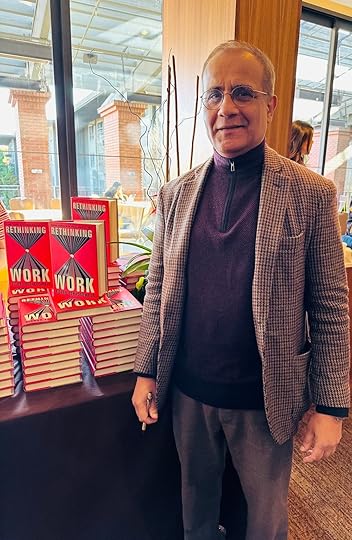
Next week (Feb 4) my second book Rethinking Work on which I have worked for two years will be published by HarperCollins in the US and India and then the rest of the world very soon after. It will be available as a hardcover, an ebook that can be read on any platform on any device, an audio book and on Kindle.
If you order it today you will have it on Feb 4. Here are all the places to order from including Amazon, Walmart, Barnes and Noble, Target, Independent Book Stores and more. For those ordering in India here is the link
The photograph above with me and stacks of the book before publication date is because HarperCollins shipped them early to a Wine Industry Conference in Monterey California that I was speaking at . HarperCollins has also agreed to ship books for events at American Express in New York, Bain Capital and their Portfolio CEO’s in Boston, the IAB Annual Leadership Meeting in Palm Springs and Nielsen’s leadership conference in Georgia all occurring this coming week before book launch.
I am now a traveling salesman!
Rethinking Work illustrates how every individual whether one is a CEO, a team leader, a middle manager or a new employee of any type and size of company in any country or industry can thrive during a period where work will transform more than it has in five decades!
If you find the writing in this thought letter worth your time, you might find the book a great resource, a tool, and a guide filled with new ideas, approaches, frameworks as well as perspectives, provocations , points of view and most importantly plans of action.
And like my first book each chapter is a book of its own versus the same chapter repeated a dozen times. There are chapters on developing reimagining strategies, recalculating financials, retraining the work force and how best machines and humans can align and what it will take to lead in the new era.
The book is likely to change not just how you think about your work and career but every aspect of your firm from strategy, to financial measurement, to talent development and organizational structure.
The book will be supported by a multi-media site, a You-Tube channel, a series of workshops, many other resources and partner as the Rethinking Work platform. You can already watch videos, listen to conversations and access research in the first baby step iteration of the platform here.
Below is a 90 second overview of the book followed by some perspectives on how work and industry will change in the next five years or less.
Some thoughts on the Future of Work.1. Most companies will have significantly fewer full time employees than they have now because of in addition to AI, companies will leverage marketplaces and the growth of fractional employment.
2. There will be far more companies in the future. This year there will be a record 6 million new firms launched in the US alone and this is likely to grow exponentially as a combination of distributed work, new technology, market places and side hustles, low code and no code solutions make it easier than ever to create and scale new firms.
3. The least important challenge in the future of work is where one works. Companies who are focussed on getting everybody back to the office are asking the wrong question. The question should be how to maximize the impact of in person interaction in ways that are personalized and customized to Client needs, type of job, seniority, personal situation and market place dynamics for any particular expertise.
How can a company talk about personalization, agility, flexibility, cost competitiveness and being future forward and then enforce a one size for all model that insists everybody return to a container of the past and be expected to be taken seriously as a company of tomorrow and hope to compete with new competitors starting today that start with a blank sheet of paper that reflect new mindsets, new marketplaces and new technology?
4. We have entered an age of de-bossification as people are rejecting “boss- like” behavior and are looking for leaders. Bosses spend almost all their time measuring, monitoring, overseeing, allocating, nitpicking and “checking-in” while Leaders spend most of their time creating, selling, guiding, building, mentoring and growing.
The modern leader will not be just full stack but wide spectrum.
They will focus not on zone of control but zone of influence.
They will combine a growth mindset, an ability to connect dots in creative ways, and communicate and inspire with data driven story telling.
The crisis that many companies face is that of leadership. Of moving forward and reimagining what it is to lead a company, understanding what a company of the future is and reimagining one’s career versus returning to the status quo.
5. Three criteria will be key to the the future of work both for the individual and company.
a) Investments in learning and training across all levels.
b) The ability to connect people, data, interfaces and opportunities inside and outside the firm in flexible and cost effective ways. We are living in a connected age and connection is the key.
c) Trust and distinctiveness. Trust will be critical in a world of algorithms, agents, and AI for companies, for brands and individuals. Distinctiveness which can be defined as differentiation through excellence in key criteria that matter will will be a key to compete.
6. The individuals and companies that will win in the future will rethink the strategy of their firm for a world of a) declining and aging populations, b) shifts of power from scale of size, resources and spending to that of data, networks and talent, c) for a world where knowledge will be free ( but not wisdom, insights and ideas) , and d) where the ability to charge for hours of input and FTE’s (Full Time Equivalents) will be destroyed by Generative, Agentic and Physical AI.
Everything and more about the book at Rethinkingwork.io
Video by Ria Tobaccowala
Photograph by Rekha Tobaccowala
January 19, 2025
3 Ways to Thrive.

Successful leaders, teams and companies that endure over the long run seek to find balance, unity, and integration.
They work to balance opposing dynamics and points of view from how they invest for today versus tomorrow and how they compose leadership teams with differing points of view.
They strive to unite their organizations to work collaboratively to achieve common goals.
They recognize that in diversity there is strength, and it is important to integrate several perspectives and skill sets to succeed in an increasingly fast moving and complex world.
To balance, to unite and to integrate is difficult because it requires nuance, trade-offs, empathy, and communication skills.
It is recognizing that there is rarely a silver bullet answer or simple and easy solution.
Balance: The Mandalorian and Lawrence of Arabia.Between 1962’s Lawrence of Arabia and 2020’s The Mandalorian there is much in common including each being an innovative use of a new film technology. It was 70 MM wide screen for Lawrence of Arabia and high-definition streaming for The Mandalorian which brought Disney into the future.
But in world view they are completely different.
In Mandalorian we sense a force and a code best captured in the line “This is the way” repeated throughout the series. There is a code of conduct almost religious. A way of doing things handed down over time. A deterministic march forward.
In Lawrence of Arabia a key theme is of old ways and traditions being challenged best captured by the line “ Nothing is written”. The desert is empty, and the sands are wiped clean with the winds of change. The past is not an anchor, and one must write, sculpt, and invent the future.
Most individuals and firms must balance both the roots (history, legacy, anchored costs, reputation, provenance, rule of law and expectations) of “this is the way” with the wings (leaps of faith, casting of on a new journey, challenging the status quo) of “nothing is written”. We must balance roots and wings.
Portfolio managers need to balance safety with risk to reach for returns while working to preserve capital.
Balancing is difficult but a focus on one extreme versus the other rarely allows for long term success.
Unite: The lessons of sports teams.Regardless of the sport, the teams that win titles tend to share two characteristics.
1) Talent: they have a disproportionate share of great talent
2) Unity: they are passionately aligned and united to achieve a common goal
Often it is not the team with the best talent that wins but the one where the talent are passionately aligned and united either due to culture or great management.
Teams are not collected they are built and forged.
It takes time but once finished in the furnace and foundry of time and experience they operate at levels of performance and delivery that create a unique competitive advantage.
Similarly, companies win contracts and retain clients and take on external challenges where there is a glue of culture, purpose and values that ensure a gestalt (1+1=3) which sets them apart. People choose with their hearts while they use numbers to justify their choice.
A leader can get elected or selected by dividing and conquering for a short while, but sustained legacy and success is usually forged through uniting and uplifting.
Unity is hard and harder still in polarizing times, but a divided house will most likely fall.
Integration: Judicious surrender to the force of opposing tendencies.If balance is often about allocating between today and tomorrow and unity about aligning different perspectives and people, integration is blending these opposing forces and personalities in a way that works and delivers.
While it may seem difficult, we all do so as individuals since each of us integrate many identities.
F Scott Fitzgerald wrote that “the test of a first-rate intelligence is the ability to hold two opposing ideas in mind at the same time and still retain the ability to function”. When applied to companies we could write that first-rate companies are able to operate two business models at the same time, one optimized for today and one focused on creating tomorrow even if it eats today.
Today the big luxury brands are seeking to integrate aspiration ( specialness, history, limited quality, high price, cathedral like retail spaces) with access ( bringing in tomorrow’s buyers, reflect unique cultures, be available online) and integrating them so the brand can combine these different product portfolios and go to market strategies without the underlying story and brand falling apart from its internal dichotomies.
The best always balance, unite and integrate.
Balance roots and wings.
Unite diverse talents and voices into a common culture.
Integrate multiple and often opposing approaches.
These are the three keys to thriving.
Rishad Tobaccowala helps people see, think and feel differently about how to grow themselves, their teams and their business via the Rethinking Work Platform , The Athena Project and the Future Does Not Fit in the Containers of the Past Initiatives . More here: https://www.linkedin.com/in/rishadtobaccowala/
January 12, 2025
Rethinking Meetings.
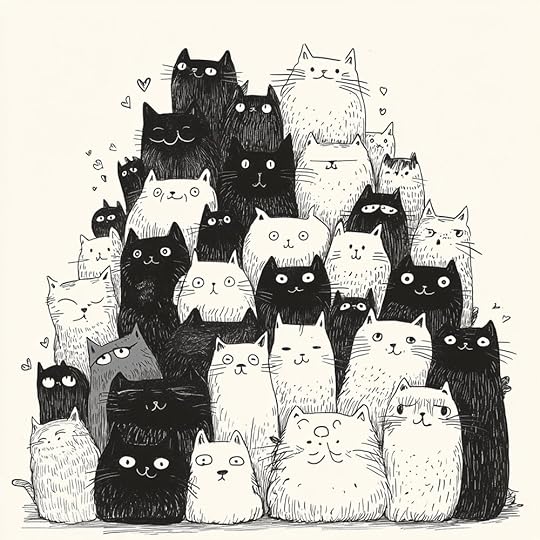
Image by Underchild using Midjourney.
We spend our time in meetings.
Meetings at work. Meeting friends. Meetings where we present and meetings where we are presented to. Meetings with all sorts of people. Meetings in the real world and meetings over screens and in the future meetings in virtual spaces.
In fact, many of us spend so much time in meetings that how we spend our time in meetings is how we spend a large part of our careers!
In business there are many who find meetings a waste of time and try to make them as short, small and few as possible. Many try to avoid meeting people and have gate keepers and delay tactics ready to brandish. Some leaders use meetings as ways to ensure discipline and instill fear.
A different way to approach meetings.There are a lot of books and articles on meeting management and how to get the most out of gatherings. Most of them are utter and complete BS because they all focus on how we can get the most out of a meeting, while the focus should be how can we give the most in a meeting.
If we go to a meeting with an “extraction” mindset versus a “giving” mindset we are likely face a number of problems including a) missing meetings where we may have been able to share our knowledge and therefore build goodwill and our reputation , b) become so focused on what we are looking for that we do not discover what we need and c) becoming over confident that we know more than anybody else that we do not learn and grow.
So, we might end up with less and less knowledge, find ourselves shocked and surprised at things that come from left field and suffer a diminished reputation.
To maximize our meeting experiences, we should focus on generosity, empathy and energy as the keys to meetings.
a) Generosity.
How can we leave the person or the people whom we are meeting with or presenting to with a gift? A gift of knowledge or insight or a way to see things that they did not have before. Something that makes them believe that it was a good use of their time to be in the meeting.
Besides knowledge some other ways to be generous include appreciation of their skills and their contributions. Everyone wants to be acknowledged and recognized for their good work.
Another way to be generous is to provide guidance. People are hungry for advice, directions and stories to navigate whatever challenge or situation they face. Providing perspectives, stories and experiences resonate and scale in empowering and growing people.
Knowledge. Appreciation. Guidance.
b) Empathy.
How can we truly understand the other persons perspective and point of view because in doing so we will grow even if you disagree with their perspective or view. If we are presenting, how can we make sure that our talk is relevant to the audience and the issues they have in mind and not some boiler plate boiled anew. Is it not ironic when speakers talk of relevance and customization and but do not customize or make relevant their content to their audience? Basically, they are saying that their time is more valuable than the audience!
Three ways to ensure empathy is to seek to understand by asking, listening and re-stating the problem and situation. By reframing the problem using analogies and other categories and finally by sharing relevant personal experiences.
Understanding signals we are listening. Re-framing telegraphs that the problem or challenge being faced has been shared by others. Personal experiences ensure a human connection and re-enforces that we have been in this person’s shoes or seen others who have been.
Understand. Reframe. Storytelling.
c) Energy.
How can we leave the folks in the meeting more energized and feeling better about themselves? So much of success is attitude, belief and hope. So many meetings leave folks dispirited, brow beaten, scared and worried. One does not have to be all bouncing beans unrealistic but let’s be pragmatically enthusiastic if we want progress.
There are three keys to ending a meeting with energy. First is clarity. People should be clear what next steps are for each of them. Second is belief which is a belief that they can tackle these next steps and finally a plan which is how they go about doing the next steps. At the end of every meeting are things clear, do people believe they have the tools and skills to do what is next and do they have a plan?
Clarity. Belief. Plan.
By focusing on giving versus getting we are almost guaranteeing a great meeting because at minimum the other folks leave the room better off and feeling positive about us. And in feeling that way they become an ally, a supporter and an advocate for us, so we get something out of it.
But what happens is much more. During the meeting once they understand that we are giving without asking, they give in return. Knowledge. Insights. Help. Lots of other stuff. Often in the meeting or as a follow up.
Finally, because we have treated their time as precious, they treat our time as precious.
And this approach to meeting works in both the real world and the virtual world. It works across every culture and country. It is effective in both personal and business situations.
Think about the other person or people.
And meetings become valuable, fun, educational and energizing.
Go beyond rethinking meetings to to Rethinking Work. Out Feb 4. Available for pre-order and bulk orders everywhere including now available for pre-order in India!
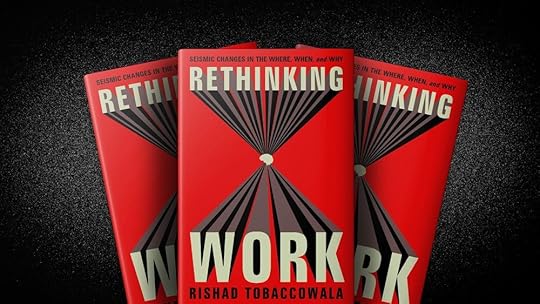
January 5, 2025
Paradox.

To be financially successful in the coming years, it’s not just about capitalizing on the new ways to make or save money.
The world is changing, setting up a situation in which organizations must learn to take two seemingly opposite actions in order to be profitable. As we move to distributed work, as technology advances, and as other trends transform society, a set of opposing but connected forces have emerged: Fragmentation and Integration.
Fragmentation is occurring because of the following four factors:
1. Employee range: different employee types have emerged, from full-time to part-time to contract worker to just-in-time employees hired through marketplaces.
2. Wider spectrum of resources: to get work done, companies are drawing from diverse places, including platforms such as Amazon Web Services and other cloud providers; different real-estate resources, from owned, rented, and accessed (WeWork); and varied ways to reach customers through traditional media, digital media, and more.
3. Differences in measurement: because of technology and a plethora of real-time data, companies can measure everything in astonishing detail, creating a wide variety of dashboards and metrics.
4. Customized products and services: companies now have a growing complexity of products and services in a world where customers expect personalized approaches and different ways to pay.
The Importance of Integration.As everything fragments into a mind-boggling variety of employee types, resources, measures, and products/services, organizations must integrate these various elements into a viable whole.
Specifically, they must create:
1. Seamless interfaces with employees regardless of employee types: consumers and customers do not want to see the complexity of different types of workers or where they may be based, so companies need to ensure seamless service and handoffs between employees. This complexity is only going to become worse at many companies, and leaders need to figure out ways to coordinate employee projects effectively.
2. Best combination of resources to manage costs: companies need to combine all the resources that go into creating products, to ensure lowest cost and continuous availability.
3. Integrated measurement and dashboards: businesses can combine myriad sources of data into an accessible, useable (by management) dashboard.
4. “Goldilocks” strategy for products and services: companies need a sufficiently large range of services and options to remain competitive but not so many that their complexity leads to increased cost and consumer confusion. The goal is to find the ideal mix.
Integrating all these elements in the face of fragmentation isn’t easy. Managing a paradox is challenging, requiring that leaders go beyond their traditional management strategies and try something new. Yet this is one of the keys to financial success in the future, making it worth the effort.
The most successful companies combine this personalization and customization at every interaction with a combined intelligence that integrates the data, focuses the choices to those most relevant while combining inputs in ways to maximize impact while minimizing costs.
The largest TV network in the world which is You-Tube is a case study of a company that on one end fragments individuals into one person media companies, personalizes messaging and content by viewer but integrates the measurement and the sales process to ensure ease by combining data and providing simplicity of access.
The future of not just media but every firm is this paradox of fragmentation through personalization by person and customization by platform, language and country on the edge combined with integration through data powered by AI algorithms at the core and center.
Work, organizational design, measurement, talent flows and company valuations will all be driven by the ability to handle the paradox.
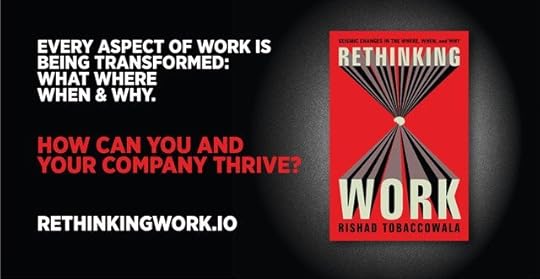
The Rethinking Work Platform is launched.
Paradox is extracted from Rethinking Work which is 30 days away and available as a book, as an e-book and as an audio book (Feb 4, 2025 including in India). Now available for pre-order on every platform.
The book will be supported by Rethinkingwork.io which will include videos, podcasts, resources and much more. The initial pre-launch platform is up at Rethinkingwork.io. where you can watch videos of the key themes (Watch), download the entire opening of the book (What’s Inside), find comments from CEO’s and more who have read the book (Testimonials), access the first 3 amazing resources on where work is going (Resources) and find a range of places to buy including 25 copies or more at half off (Where to Buy).
There will be much more coming once the book launches.
Until then it would be terrific if you pre-order. This book will change your perspective on work and provide not just trends, cases and points of view but highly actionable frameworks, provocative new data and a vision for how to best thrive in the tsunami that has just begun regardless if you are a CEO or a trainee.
Work will change more between 2019 and 2029 than it has in the five decades before.
Rethinking Work is one way to prepare your firm and yourself.
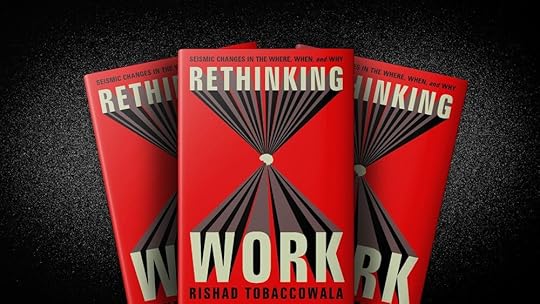
More on Rishad Tobaccowala here: https://rishadtobaccowala.com/bio



